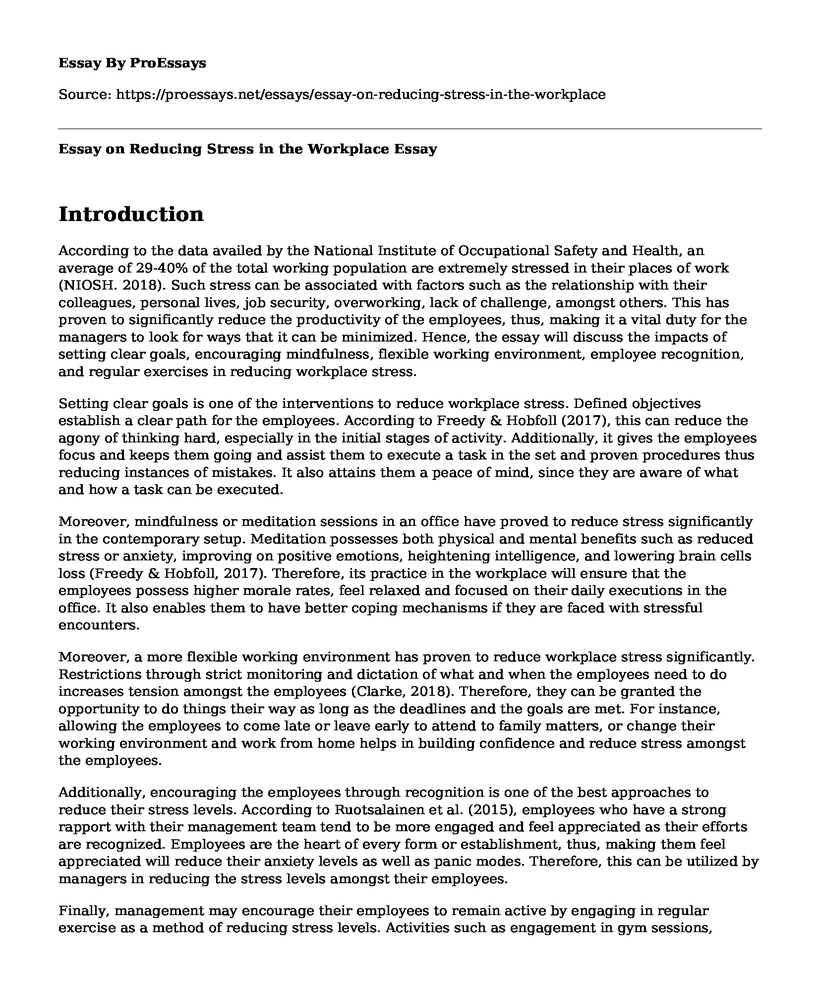Introduction
According to the data availed by the National Institute of Occupational Safety and Health, an average of 29-40% of the total working population are extremely stressed in their places of work (NIOSH. 2018). Such stress can be associated with factors such as the relationship with their colleagues, personal lives, job security, overworking, lack of challenge, amongst others. This has proven to significantly reduce the productivity of the employees, thus, making it a vital duty for the managers to look for ways that it can be minimized. Hence, the essay will discuss the impacts of setting clear goals, encouraging mindfulness, flexible working environment, employee recognition, and regular exercises in reducing workplace stress.
Setting clear goals is one of the interventions to reduce workplace stress. Defined objectives establish a clear path for the employees. According to Freedy & Hobfoll (2017), this can reduce the agony of thinking hard, especially in the initial stages of activity. Additionally, it gives the employees focus and keeps them going and assist them to execute a task in the set and proven procedures thus reducing instances of mistakes. It also attains them a peace of mind, since they are aware of what and how a task can be executed.
Moreover, mindfulness or meditation sessions in an office have proved to reduce stress significantly in the contemporary setup. Meditation possesses both physical and mental benefits such as reduced stress or anxiety, improving on positive emotions, heightening intelligence, and lowering brain cells loss (Freedy & Hobfoll, 2017). Therefore, its practice in the workplace will ensure that the employees possess higher morale rates, feel relaxed and focused on their daily executions in the office. It also enables them to have better coping mechanisms if they are faced with stressful encounters.
Moreover, a more flexible working environment has proven to reduce workplace stress significantly. Restrictions through strict monitoring and dictation of what and when the employees need to do increases tension amongst the employees (Clarke, 2018). Therefore, they can be granted the opportunity to do things their way as long as the deadlines and the goals are met. For instance, allowing the employees to come late or leave early to attend to family matters, or change their working environment and work from home helps in building confidence and reduce stress amongst the employees.
Additionally, encouraging the employees through recognition is one of the best approaches to reduce their stress levels. According to Ruotsalainen et al. (2015), employees who have a strong rapport with their management team tend to be more engaged and feel appreciated as their efforts are recognized. Employees are the heart of every form or establishment, thus, making them feel appreciated will reduce their anxiety levels as well as panic modes. Therefore, this can be utilized by managers in reducing the stress levels amongst their employees.
Finally, management may encourage their employees to remain active by engaging in regular exercise as a method of reducing stress levels. Activities such as engagement in gym sessions, walking sessions, and yoga exercises have proven over time to increase their body movement thus allowing them to shift their efforts away from the stressing situations in the workplace (Clarke, 2018). For instance, a quick 2-3-minute stretch after maybe three-hour interval can assist in reducing exhaustion, especially from employees who are always staring at a computer screen.
Conclusion
In conclusion, the essay has discussed the impacts of setting clear goals, encouraging mindfulness, flexible working environment, employee recognition, and regular exercises in reducing workplace stress. Such measures reduce the agony of thinking hard, anxiety, brain cell loss, increasing their motivation levels, and making them feel valued and appreciated. Such approaches hence are vital in reducing stress levels amongst employees in their workplace.
References
Clarke, L. (2018). How Great Managers Can Help Reduce Stress in the Workplace. Retrieved from https://inside.6q.io/reduce-stress-in-the-workplace/.
Freedy, J., & Hobfoll, S. E. (2017). Conservation of resources: A general stress theory applied to burnout. In Professional burnout (pp. 115-129). Routledge.
NIOSH. (2018). Stress.... At Work: Stress in Today's Workplace. Retrieved from: https://www.cdc.gov/niosh/docs/99-101/default.html.
Ruotsalainen, J. H., Verbeek, J. H., Marine, A., & Serra, C. (2015). Preventing occupational stress in healthcare workers. Cochrane Database Syst Rev, 4.
Cite this page
Essay on Reducing Stress in the Workplace. (2022, Jul 01). Retrieved from https://proessays.net/essays/essay-on-reducing-stress-in-the-workplace
If you are the original author of this essay and no longer wish to have it published on the ProEssays website, please click below to request its removal:
- Symbolic Analysis of Internship Workplace
- Essay Sample on Managing Equality and Diversity at Work
- Essay on Staff Burnout & Compassion Fatigue: Study at Heartland Behavioral Healthcare
- Essay on Hiring Employees: Tips to Get the Best Candidate
- Essay Example on Using I-Language and You-Language to Promote Self-Awareness and Healing
- Essay Example on Sexual Expressions in Later Life: Benefits & Challenges
- Cognitive Ability: 100% Innate or Learned? - Free Essay Example







